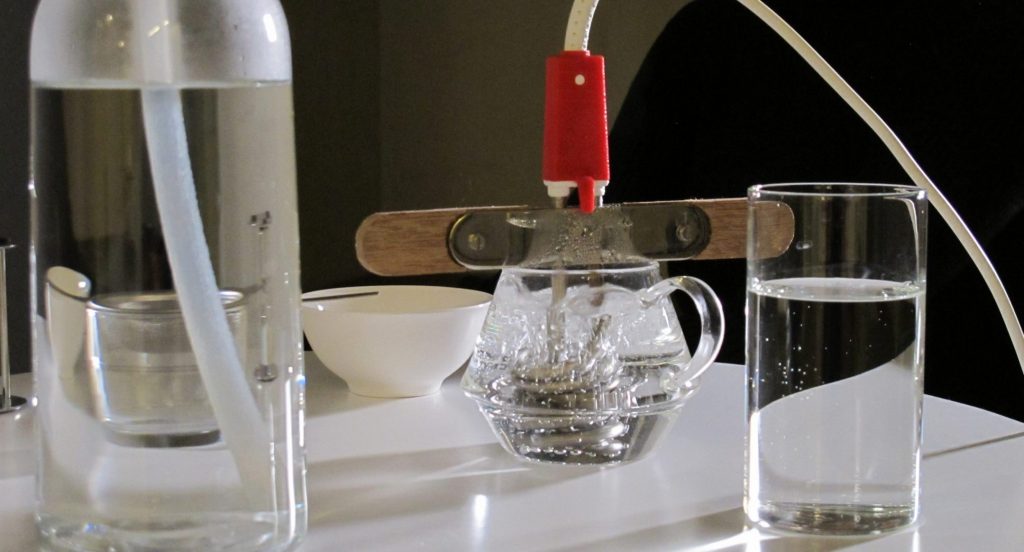
During the previous experiment with both the interactive and analogue installation users reported obstacles which took them out of the experience and hindered a fluid interaction with the objects. Some of them were technology-related others might be solved at the analogue level. These were
- Fear of spilling (water, tea), solution: using a genuine teapot with a spout
- Fear of making a mistake or forgetting certain steps, solution: using affordances and position to clarify the use of objects (teapot, sieve on the cup, in a second iteration sieve on rinse bowl), reducing the number of objects (just one teapot, not a “kettle” and a “pot”).
- Wondering about protocol (what is allowed?), solution: make clear there are no rules, they can take their time for all the activities
- Fear of burning something with the immersion heater, solution: stabilise heater
- Uncomfortable sitting position, solution: a new stool with adjustable height, higher table
- Some objects are user-unfriendly, solution: rendering the construction for water decanter unnecessary
In general: make the appearance installation less alien, more friendly and survey-able. (The aim was to create a sense of safety.) Reduce the use of colour, harmonise materials. Figure 1 shows a comparison between the two versions.
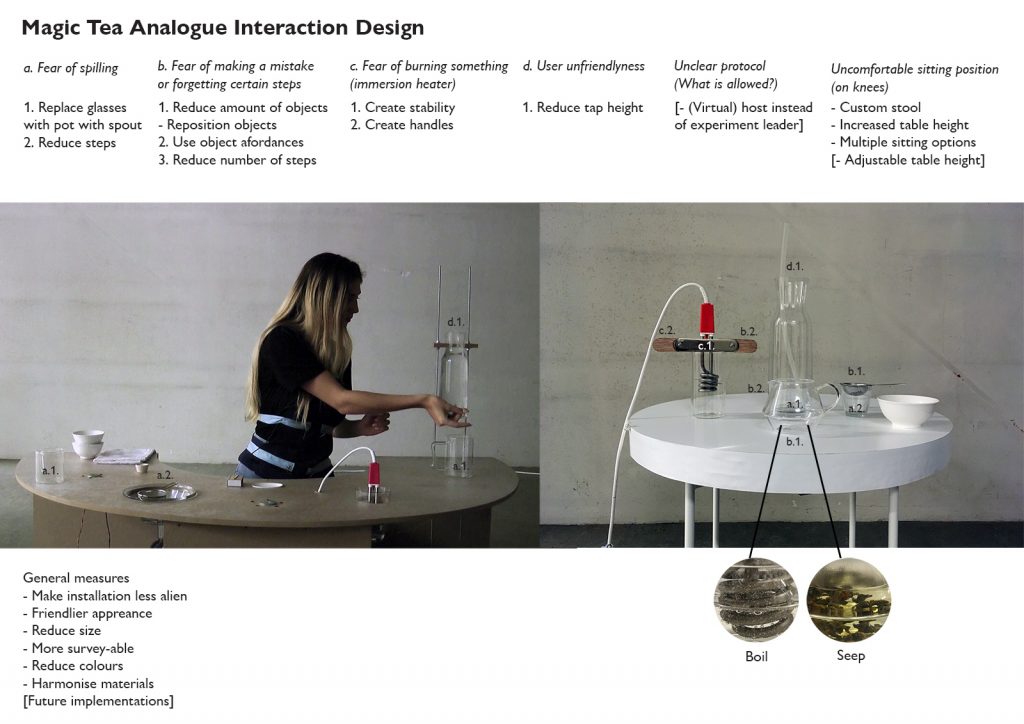
Method
The main question for this experiment was: Does modifying the Magic Tea objects and interactions take away certain obstacles for experiencing a self-transcendent, mystical experience? In total 10 participants (2 male, 8 female, mean age 36) took part in the second experiment of the analogue design. Seven of them were first-time users three were returning participants of the first analogue version. The experiment design (fig. 2) was identical to the first run, only the duration of the “cooling down” period was shortened from five to three minutes. In total four research methods were used to get insight into the user experience:
- Two types of questionnaires:
- The validated Revised Mystical Experience Questionnaire (MEQ; 30 items)
- The non-validated 5 point Likert scale Factors for Awakening, stress & relaxation.
- Observation during the activity
- An interview after the activity. The starting point for the interview was the feedback capture grid (fig. 7) by Teo Yu Siang and Interaction Design Foundation.
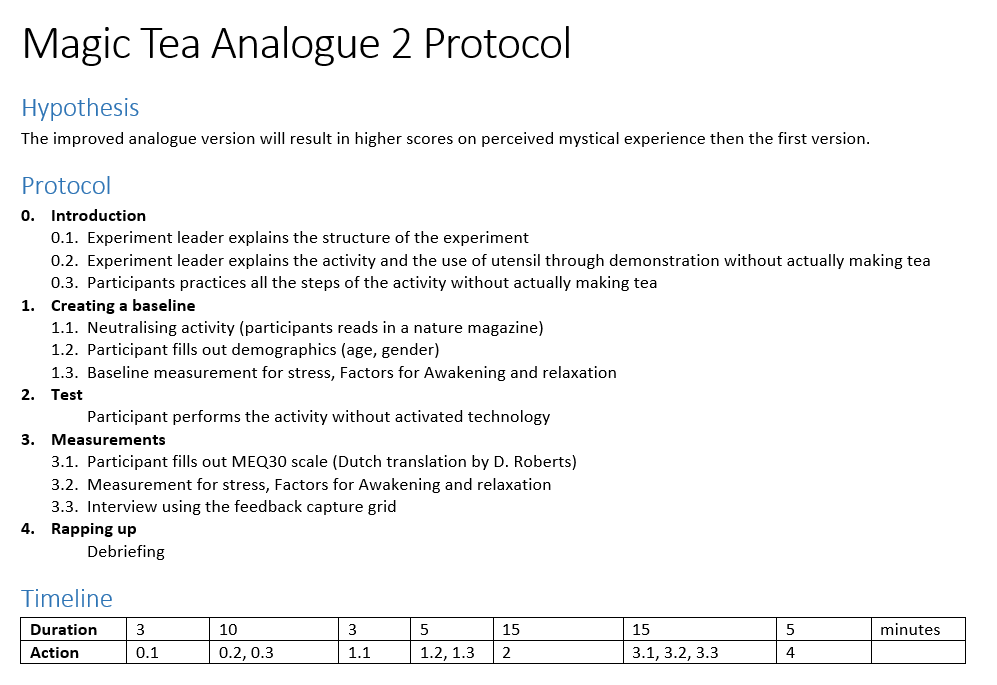
Results
Observations
The main observations during the tea preparation were: the success at tapping the water is mixed. Some participants succeed the first time, some had to try a couple of times, one participant couldn’t tap the water in as prescribed. But all the users remained calm and asked for help if necessary.
It was notable that users moved the objects a lot more frequently compared to the first version where all the utensils had a designated position.
The immersion heater caused participants to burn their hands on the steam from the pot. This was prevented by an explicit warning during the instructions.
Some participants shifted positions on the seat and some had problems squatting to sit down.
Factors for Awakening questionnaire
Factors for Awakening are derived from an ancient Buddhist text. They describe the conditions for arriving at awakening and can therefore be seen as factors which may promote transcendence. Mind-states stress and relaxation have been added to the original list of factors.
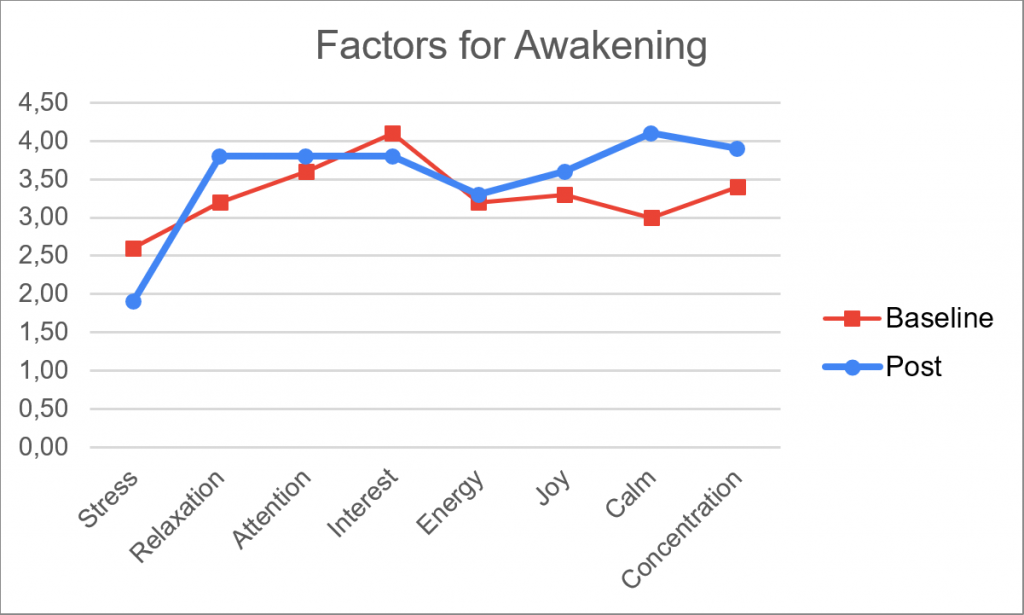
For all ten participants, scores on all factors are higher compared to baseline (fig 3). Except for interest (-1.3). This is a recurring phenomenon in the Magic Tea experiments and probably due to the experiment setting in which participants are curious about what will happen.
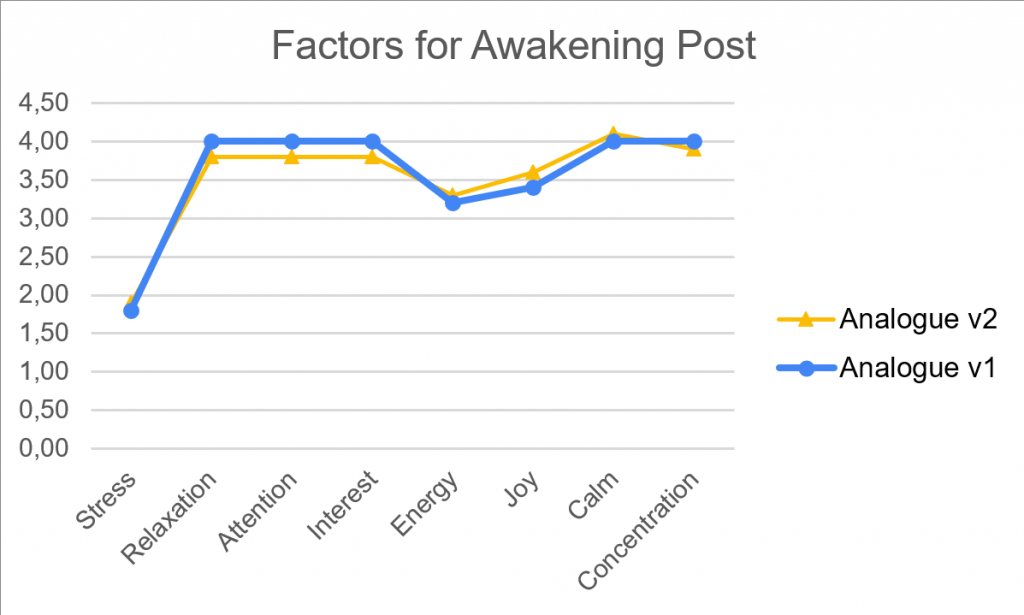
When comparing version 1 with version 2 (fig. 4) the latter scores slightly less on relaxation (-0.2), attention (-0.2), interest (-0.2) and concentration (-0.1) and slightly higher on joy (+0.2). Stress, energy and calm scored more or less the same in both versions
MEQ30 scale
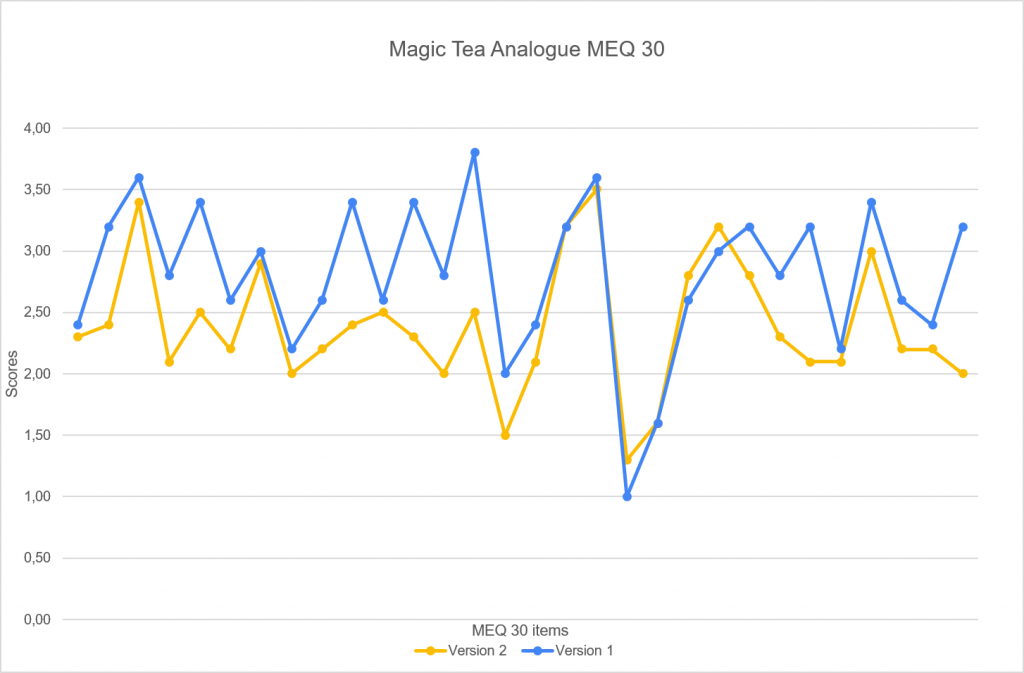
The MEQ30 is a validated scale developed to measure the mystical experience effects of hallucinogenic drugs (Psilocybin). These are comparable to non-drug induced experiences which is why it is used in this experiment. The scores of both versions (fig. 5) follow mostly the same trend but the most recent version scores lower on all factors (total means 72) except for positive mood which is similar to the previous outcome (total means 84). Especially the unity factors and noetic quality and sacredness score lower. There is however a big difference between the first time users and the returning participants (view below).
Conclusions
In the new setup participants still like the activity and the calm, focus and fascination it brings. They enjoyed handling the artefacts, their appearance and liked the taste of the tea. The improvements worked, there were fewer questions about the steps and users expressed less anxiety. The objects were easier to handle except for the heater. After adjustments to the handle, this was no longer an issue.
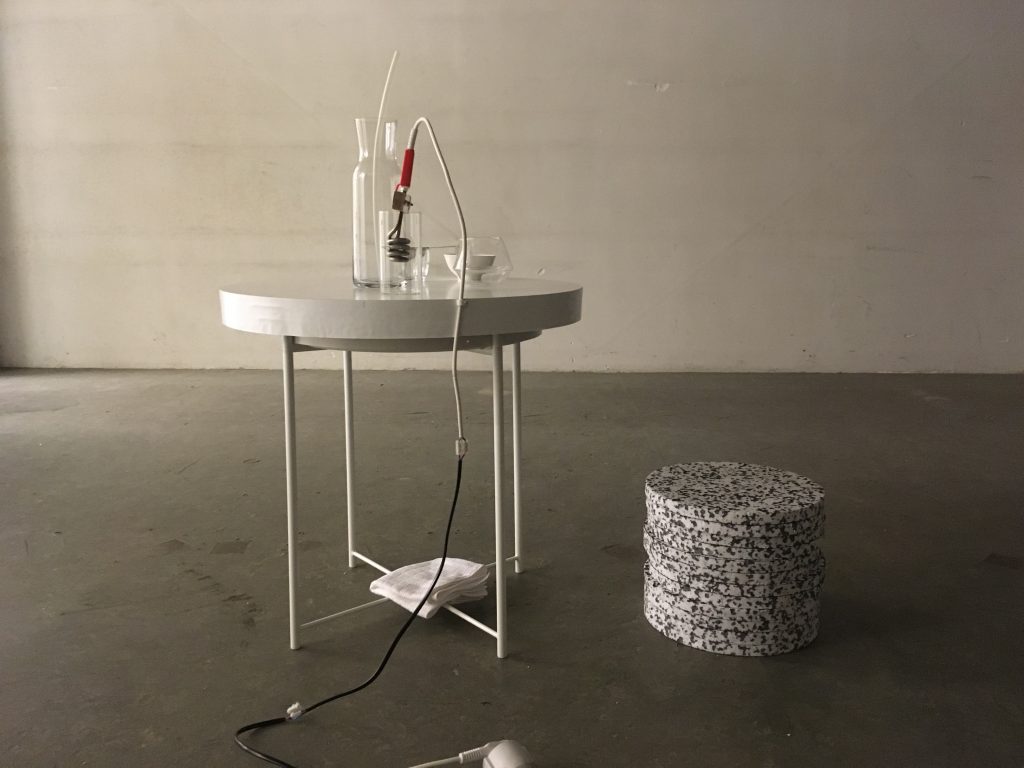
The seat (fig. 6) was controversial, on the one hand, participants liked the way it supports attention and has an unusual height, some people found it comfortable. On the other hand, many people complained about it being too low, uncomfortable and unstable.
The environment plays an important role in the perception of the experience. The silent, bare-floored, windowless cellar improved focus for quite a few participants while others found it cold and uninviting which took away some of the enjoyment.
The experiment setting also interfered with the experience. Some users were very conscious of being observed. Others didn’t feel like finishing their tea because the experiment setting provided no context to drinking tea. The feedback grip below lists an overview of user comments.
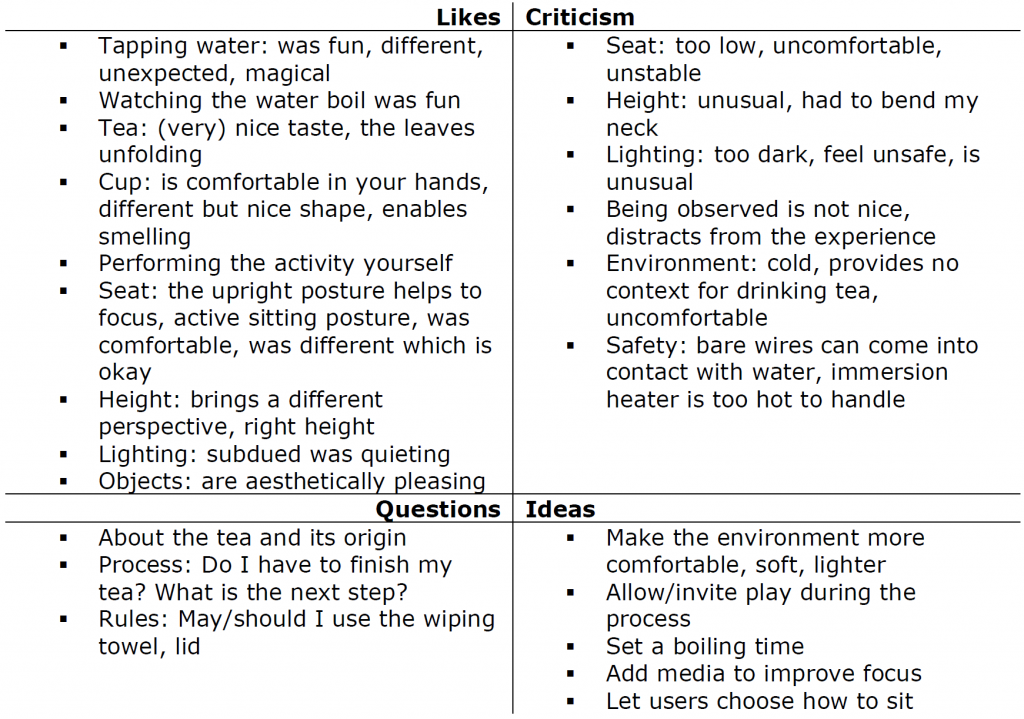
Additional insights from the interviews
People commented on their personality and the experience. Personality traits influence the way users approach and experience the installation. Comments like: I tend to adhere to instructions, I am a thinker, not a doer, I can become fascinated by small things and I am down to earth determine how and if users handle the objects and how they experience them. This varies a lot from person to person.
Users comment on the sharp contrast with their usual mind-state. They feel calmer, more attentive to the activity, more present. They consider it a nice break from their day to day way of doing things. They enjoy the sensory experience (sight, smell, taste).
Returning participants
Because the main goal of this experiment was to verify whether the changes to the installation are an improvement, the response from the previous users of the analogue installation was crucial for determining success. The results and reactions from the returning participants were mixed and also deviated from the general findings on some crucial aspects.

Factors for Awakening
In line with the general trend returning participant scores for the Factors for Awakening questionnaire were lower for the second version compared to the first version of the installation. (Table 1, column 1)
When comparing the baseline and post-intervention scores for this measure (table 1 column 3 and 4) we see a similar pattern in both instances. User A displays a higher positive effect, user C showing a lower but positive effect and user B going from no effect to a negative effect (-2.0)
Interviews
They found the experience still pleasant and calming but two out of three (B&C) commented on the new table and layout of the objects which they found interfered with the intensity and pleasantness of the experience. User A, however, found the new setup less intimidating and therefore more relaxing. For all users, the changes to and selection of the utensils was perceived as positive and aesthetically more pleasing. This mostly correlates with the Factors for Awakening outcomes.
MEQ30
The scores on the MEQ30 questionnaire (table 1 column 2) did not align with the above findings. All participants scored higher on this scale, also the critical users B (+5.0) and C (+1.0). The results going up also contrasts with the general score which was 12 points lower overall. The hypothesis for these results was that filling in the questionnaire for the second time had made it less alien and easier to answer. A follow-up interview was conducted to test it. User A (+7.0) explained that the second experience was more meditative for him which could explain why he could relate more to language and themes of the scale. User B found that she was in a very different mind-state the second time. Due to tiredness, her feelings were blunted. Her results indeed show fewer extremes which results in a higher total score. Participant C (+1.0) found that the second time she had to think harder about the answers. Her feelings were less obvious to her. To comply and give valuable feedback she felt she had to dig much deeper. The underlying reasons for the contradictory scores appear to be very individual and don’t match the hypothesis.
Conclusions
The main question for this experiment was: Does modifying the Magic Tea objects and interactions take away certain obstacles for experiencing a self-transcendent, mystical experience? Looking solely at the results from the Mystical Experience Questionnaire the answer is no. The experience was perceived as having less mystical properties.
There were three main changed made to the design: the objects, the seat and the shape and size of the table and the way the utensils were laid out. Reactions to the objects were positive both from first-time and returning participants this applies to the usability as well as the aesthetics. The seat was found to support attention but many users also found it uncomfortable. The layout and size of the table were considered less positive and supportive of the activity by 2 returning participants. This is reflected in the lower Factors for Awakening scores. But it didn’t impact the MEQ30 scores as both scored higher as did the one returning visitor preferred the new table and scored 11 points higher on the MEQ30 scale but also lower on the Factors for Awakening. From this experiment, it doesn’t become clear what caused the big difference in the MEQ30 results.
One reason for the lower MEQ30 scores maybe the big difference in mean age, 48 for the first experiment and 36 for the second. Older people may be more familiar with the language used in the questionnaire making it easier for them to score on abstract concepts like holiness, reverence and the absolute. The Factors for Awakening scores seem to correspond more with the users’ experience. The way the questions are perceived should be explored in the debriefing interviews.
For the design, the main insights are that the preference for the height and type of the chair are very personal. There isn’t one size that fits all. The next design will allow participants to choose from three options. The next iteration will combine the usability and aesthetics from the second version with the more procedural table layout of the previous version. The process should be challenging in the right way: through intriguing interaction and not by discomfort. More attention will go to the environment of the installation to make it feel more safe and relaxing.
Supported by Avans University of Applied Sciences, Centre of Applied Research for Art